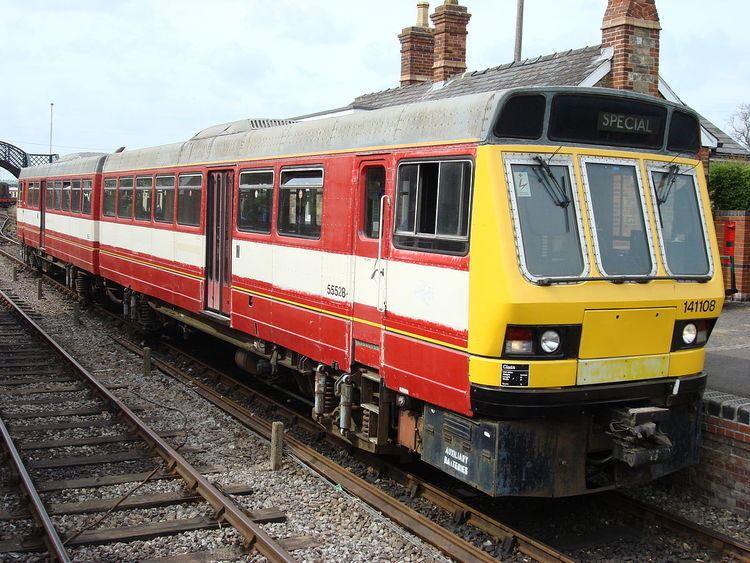In service 1984 - 2005 Family name Pacer Formation 2 carDMS+DMSL | Refurbishment 1988 - 1989 | |
 | ||
Order no. 30977 (DMS)30978 (DMSL) | ||
The British Rail Class 141 was the first production model of the Pacer diesel multiple units. Its lifespan in the UK was 14 years, some units were exported to Iran operating for 8 years, for a total lifespan of 22 years.
Contents
Description
In the early 1980s British Rail were looking to replace the remaining 1950s first generation diesel multiple units on lightly used branch lines. Financial pressures precluded them ordering more heavyweight second generation units (the business case could not be made to balance) so were looking for a cheaper alternative.
British Rail engineers looked at the Leyland National bus, then in widespread usage, with its modular design as a basis for the design. Several single and two car prototypes were built before an order was placed with Leyland Bus for twenty class 141 two car units in 1984.
The units were notoriously unreliable, but reliability improved when the units were modified by Hunslet-Barclay between 1988 and 1989. At the same time the railway couplings (which was a Buckeye coupling) were replaced with the type fitted to the later Class 142, for more flexible working.
Both axles (one driving per coach at the inner end) were fitted directly to the chassis rather than being mounted on bogies, leading to a rather rough ride especially over pointwork, because of this the units were generally less popular with passengers.
The units were based mainly in and across West Yorkshire on routes radiating from Leeds, where they worked up until 1997 when they were replaced by Class 142. They were sponsored by West Yorkshire Passenger Transport Executive, and were initially painted in the PTE's Verona green and buttermilk livery with "MetroTrain" branding, later receiving the red and cream "Metro-Train" livery.
The units were numbered from 141001 to 141020. After modification they became 141101 to 141120, although not in order, since the opportunity was taken to match the final digits of the unit numbers with those of the vehicle numbers.
Overseas
In 1984, a Class 141 unit was built for trial running in Malaysia and Thailand. The unit was re-gauged to metre gauge. The trial running wasn't successful. The vehicle was different from the twenty British trains having only longitudinal seating for 120 passengers and space for another 140 standing. Only 1 car was powered with the other being a trailer vehicle. After the unsuccessful trial in Thailand the Pacer went to Malaysia and then to Indonesia for further evaluation. It was last seen outside the Ulu Yam station, on a railway siding, in Malaysia in fairly derelict condition in 2000.
At the end of their career with British Rail, 12 units were sold to Islamic Republic of Iran Railways and were exported during 2001/2002. with two spotted in service in 2005, All units have since been withdrawn and replaced by new DMUs. Two units (106 & 112) were exported to the Netherlands but they are not currently being used. Some units remain in the United Kingdom with three units operate in preservation:- 141103 at the Weardale Railway, 141108 at the Colne Valley Railway, and 141113 at the Midland Railway – Butterley. One unit (141110) is at the Weardale Railway, but is not in operational condition (spares donor) and one vehicle has been scrapped.
Non-passenger use
Unit number 141118 was modified for use as a weedkilling unit by Serco. It gained a grey and red livery and black wrap-around window surrounds. It was among the units later exported to Iran. A photograph of this unit, in SERCO livery, at Huddersfield is shown on page 36 of Modern Locomotives Illustrated - August/September 2012.
